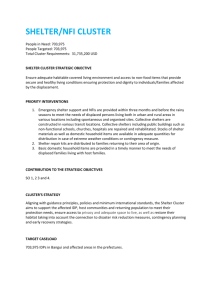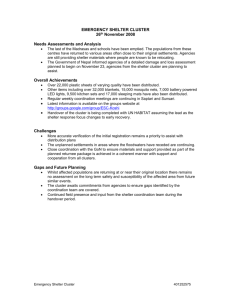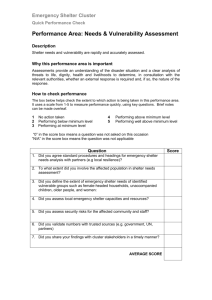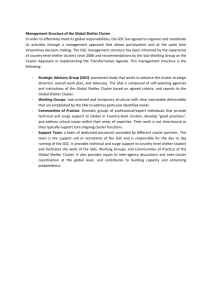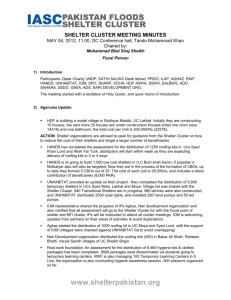Kenya-Factsheet - Shelter Cluster
advertisement
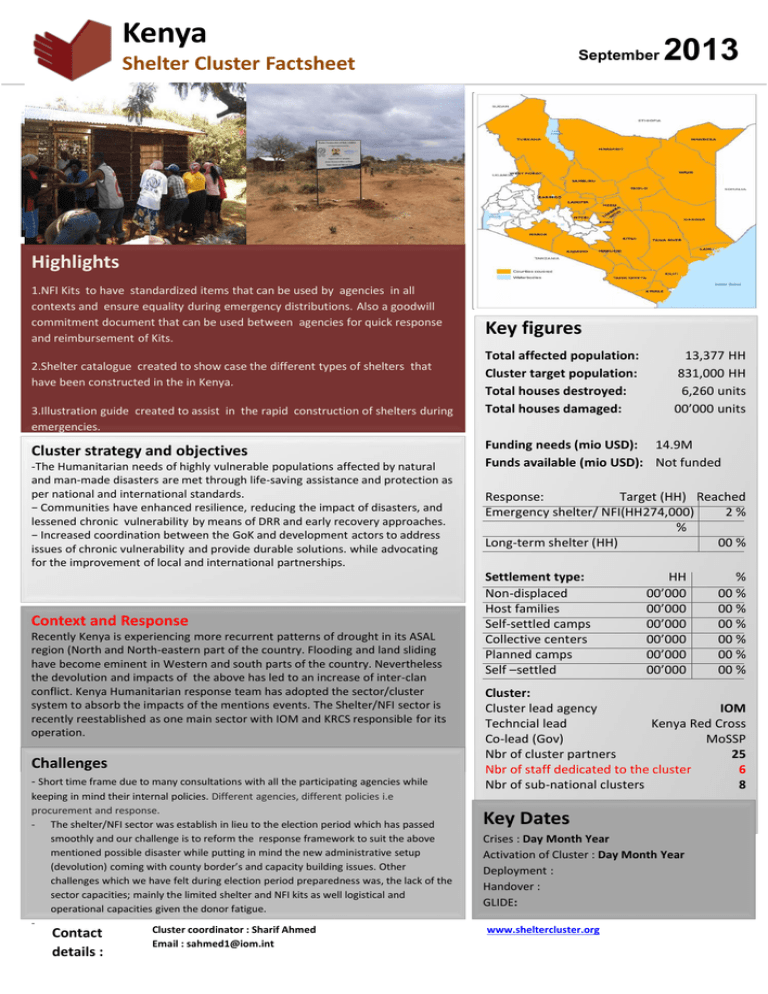
Kenya September Shelter Cluster Factsheet 2013 Highlights 1.NFI Kits to have standardized items that can be used by agencies in all contexts and ensure equality during emergency distributions. Also a goodwill commitment document that can be used between agencies for quick response and reimbursement of Kits. 2.Shelter catalogue created to show case the different types of shelters that have been constructed in the in Kenya. 3.Illustration guide created to assist in the rapid construction of shelters during emergencies. Cluster strategy and objectives -The Humanitarian needs of highly vulnerable populations affected by natural and man-made disasters are met through life-saving assistance and protection as per national and international standards. − Communities have enhanced resilience, reducing the impact of disasters, and lessened chronic vulnerability by means of DRR and early recovery approaches. − Increased coordination between the GoK and development actors to address issues of chronic vulnerability and provide durable solutions. while advocating for the improvement of local and international partnerships. Context and Response Recently Kenya is experiencing more recurrent patterns of drought in its ASAL region (North and North-eastern part of the country. Flooding and land sliding have become eminent in Western and south parts of the country. Nevertheless the devolution and impacts of the above has led to an increase of inter-clan conflict. Kenya Humanitarian response team has adopted the sector/cluster system to absorb the impacts of the mentions events. The Shelter/NFI sector is recently reestablished as one main sector with IOM and KRCS responsible for its operation. Challenges - Short time frame due to many consultations with all the participating agencies while keeping in mind their internal policies. Different agencies, different policies i.e procurement and response. - The shelter/NFI sector was establish in lieu to the election period which has passed smoothly and our challenge is to reform the response framework to suit the above mentioned possible disaster while putting in mind the new administrative setup (devolution) coming with county border’s and capacity building issues. Other challenges which we have felt during election period preparedness was, the lack of the sector capacities; mainly the limited shelter and NFI kits as well logistical and operational capacities given the donor fatigue. Cluster coordinator : Sharif Ahmed Contact Email : sahmed1@iom.int details : Key figures Total affected population: Cluster target population: Total houses destroyed: Total houses damaged: 13,377 HH 831,000 HH 6,260 units 00’000 units Funding needs (mio USD): 14.9M Funds available (mio USD): Not funded Response: Target (HH) Reached Emergency shelter/ NFI(HH274,000) 2% % Long-term shelter (HH) 00 % Settlement type: Non-displaced Host families Self-settled camps Collective centers Planned camps Self –settled HH 00’000 00’000 00’000 00’000 00’000 00’000 % 00 % 00 % 00 % 00 % 00 % 00 % Cluster: Cluster lead agency IOM Techncial lead Kenya Red Cross Co-lead (Gov) MoSSP Nbr of cluster partners 25 Nbr of staff dedicated to the cluster 6 Nbr of sub-national clusters 8 Key Dates Crises : Day Month Year Activation of Cluster : Day Month Year Deployment : Handover : GLIDE: www.sheltercluster.org Needs, response and gap Needs Response Gap (H =D-E-F) (A) # Affected HH (B) #HH Selfrecovered (C=A-B) #HH Still affected (D= 50% C) Targeted by Cluster (vulnerable HHs) (E) #HH to be assisted by Govt. (F) #HH to be assisted by humanitarian actors (confirmed funds) (G) #HH served #HH not yet funded NFIs 15,000 1,000 14,000 7,000 2,000 0 0 0 Emergency Shelter 6,260 539 5,726 3,000 1,710 0 0 0 Long-term shelter 0 0 0 0 0 0 0 0 Note i. Figures above represent current and future plans ii. No funding confirmed at the moment Budget gap : Shelter solutions House Tent Shed Collective centers Improved shelter No shelter Households 539 217 0 0 0 0 Percentage 0% 0% 0% 0% 0% 0% Map : Who is doing what where in shelter More maps available at : (hyperlink) https://kenya.humanitarianresponse.info/clusters/emergency-shelter-and-nfi Table showing HUB coverage by Shelter Cluster partners with Capacities HUB Covering districts Shelter Cluster presence Isiolo Moyale, Marsabit, Isiolo UNICEF, KRC Nakuru Eldoret Mombasa Garissa Kisumu Nakuru, Naivasha, Kipkelion, Molo, Kitale, Nandi, Uasin, Gishu, Burnt Forest Samaritan’s Purse, IOM, OCHA, KRC Mombasa, Lamu, Tana River, Kwale, World Vision, KRC Malindi Garissa, Wajir, Manerda, Ijara, Fafi, NRC, IOM, UNICEF Hagadera Nyanza, Western Turkana Nairobi (Urban) NRC, IOM Njoro, Narok, Subukia UNICEF, World Vision, KRC World Vision, UNICEF, NRC Kibera, Makandara, Kasarani KRC, CHF, Samaritan’s Purse, Other Cluster lead: IOM Partners of the Shelter Cluster: UNICEF, World Vision
